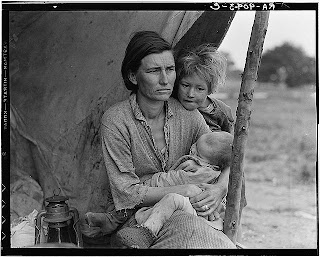Why the project has signicant impact on the society?
The project has significant impact on the society because of "the adverse effects of the Great Depression, the Dust Bowl, and increasing farm mechanization"(American Memory). The Farm Security Administration (FSA) and The Office of War Information (OWI) have such a major role in the history of photography. "The photographers in both units documented America's mobilization during the early years of World War II, concentrating on such topics as aircraft factories and women in the workforce." (American Memory) The photos you see around the time of the Great Depression , they contributed to that and the history of photography of the time.
*Below are just two pictures taken by the The Farm Security Administration and The Office of War Information (OWI)
 |
| Washington, D. C. Government charwoman. 1942. Photographer: Gordon ParksReproduction Number: LC-USZ62-80024 |
 |
| Washstand in the dog run...Hale County, Alabama. 1935 or 1936. Photographer: Walker EvansReproduction Number: LC-USF342-8133A |
What was the role of Migrant Mother photograph in the period or great depression and what is it nowadays?
The role of the "Migrant Mother" photo at the time of the great depression was the life of a migrant at the time. No money,struggled to provide for their family, and making do with the resources they had. The overall lifestyle was depressing because these people literally had to give up everything they possibly had to survive. The role of the photo now is for people to see and understand the struggles these people faced at the time. We dont have the same struggle, it was definately harder then than it is now. There is far more resources for the less fortunate now then there was for the people who struggled back in the day.
*The pictures below show the "migrant mother". This was her life, her family and her struggle
Reference
1. Color and Black-and-White Photos ." American Memory. N.p., 15 12 1998. Web. 12 Feb 2011. http://memory.loc.gov/ammem/fsahtml/fahome.html.
2. "The Office of War Information." American Memory. N.p., 15 12 1998. Web. 12 Feb 2011. http://memory.loc.gov/ammem/fsahtml/owiinfo.html.
3. "Dorothea Lange's "Migrant Mother" Photographs in the Farm Security Administration Collection: An Overview." Migrant Mother. N.p., 22/10/2010. Web. 12 Feb 2011. http://www.loc.gov/rr/print/list/128_migm.html


No comments:
Post a Comment